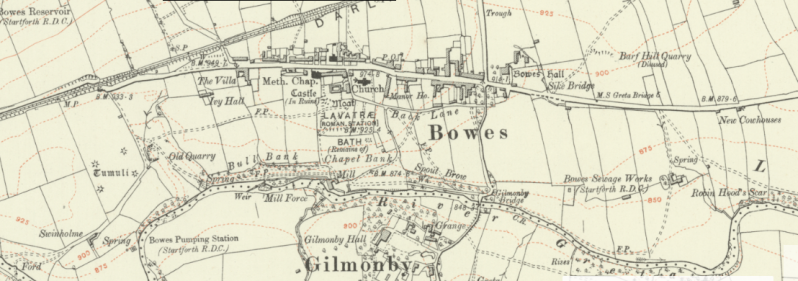Mill Force Waterfall Bowes
If you love uncovering quiet spots with a story behind them, Mill Force at Bowes is a perfect little find. This short walk takes you past castle ruins, traces of an old Roman fort, riverside scenery and a historic waterfall once used to power the village mill. It’s an easy, family friendly route with plenty of interest packed into just over a mile, ideal for a gentle stroll or a quick explore with the children (and the dog, of course 🐾)
🧭 Part of Discover Teesdale
our guide to the walks, waterfalls, history and peaceful places that make Teesdale special.

Quick Facts
📍 Location: Bowes, County Durham (DL12 9HR)
🚗 Parking: carpark opposite Bowes & Gilmonby Village Hall
🚶♂️ Distance:1.34 miles / 2.1 km circular
⏱ Time: Around 30 minutes
🐾 Dog friendly: Yes, keep dogs on leads
🗺 Map: OS Explorer OL31 – North Pennines
💧 Route: Riverside and village paths
🌦 Difficulty: Easy – suitable for families
🥾 The Walk
Start from the small car park opposite Bowes & Gilmonby Village Hall, just at the bottom of the village. Head into the village and you’ll soon see the stone remains of Bowes Castle, standing proudly above the River Greta. The castle was built in the late 12th century by Henry II to guard the old Roman road across the Stainmore Pass, and you can still wander around the ruins today for free.
From here, follow the footpath that curves around the edge of what was once the Lavatrae Roman Fort — Bowes’ earliest settlement. Although little now remains on the surface, the raised ground and layout give a real sense of where the Romans once stood watch over the valley. Information boards near the castle help bring the history to life.
Continue down the track towards the river, where the sound of rushing water starts to build. A short grassy path brings you to Mill Force Waterfall, a lovely stepped cascade tucked away in trees on the River Greta. It’s not a huge drop but it’s full of character, and you can still spot some of the old mill stonework close to the riverbank. On a quiet morning it feels miles from anywhere, just birdsong, the water, and a bit of local history beneath your feet.
After enjoying the waterfall, follow the path east along the river towards Gilmonby Bridge. You’ll see wide views back over the valley, with the A66 running high above on its embankment, hard to imagine that this peaceful little village once sat beside one of the main routes across the Pennines.


💡 Route Information
Digital route: Mill Force Bowes walk
This short route is 1.34 miles and takes roughly 30 minutes. It’s suitable for families and dogs, and follows easy village and riverside paths.
While you’re in Bowes, it’s worth adding God’s Bridge
to your list, the walk between the two is full of character and lovely riverside scenery.
🏰 History and Heritage
Bowes has layers of history stacked together like nowhere else in Teesdale. The Romans built Lavatrae Fort here nearly 2,000 years ago to control the Stainmore Pass, one of the key crossings between Yorkshire and the north-west. Centuries later, Bowes Castle was constructed within the same walls to protect travellers and traders along the same route.
The name “Mill Force” hints at the area’s industrial past. A water-powered corn mill once stood beside the falls, using the drop in the River Greta to turn its wheel. Historic Ordnance Survey maps from the 1800s show the mill buildings, a weir and the mill-race channel still clearly marked. It likely served the local community and perhaps the castle’s garrison before falling into disuse as milling technology changed.
If you look carefully near the waterfall, you can still spot the old stonework where the mill stood — the piers and cut channels that once carried water to the wheel. It’s a quiet reminder of how important small rural mills were to village life long before electricity or machinery.
Below are two fascinating historic map extracts showing exactly where the mill once stood and how the village looked in the 19th century (courtesy of the National Library of Scotland)

Historic Ordnance Survey map of Bowes and Mill Force (© National Library of Scotland).

19th-century Ordnance Survey map showing the mill site and Bowes village (© National Library of Scotland).

❓ Frequently Asked Questions
Where is Mill Force Waterfall?
Mill Force is on the River Greta, just below Bowes village in County Durham. It’s easy to reach on foot from the village centre, following a short riverside path past Bowes Castle and Lavatrae Roman Fort.
Is Mill Force suitable for families and dogs?
Yes — it’s an easy circular walk of about 1.3 miles with gentle terrain. It’s great for families and dogs, though you may need to keep dogs on a lead near livestock or open fields.
What’s the history behind the name “Mill Force”?
The waterfall once powered a watermill that served the village. Historic Ordnance Survey maps show the mill buildings and weir beside the river. The word Force comes from Old Norse, meaning waterfall, a reminder of the Viking influence across northern England.
📍 See it on Google Maps
Check out our Local Guide posts and photos for Mill Force on Google Maps:
Explore more in Teesdale
Love places where history and nature meet? These nearby spots combine waterfalls, old ruins and peaceful walks:
📜 Affiliate & Source Note
Historic maps © National Library of Scotland.
Outdoor Exploring Family is supported by readers — some links may be affiliate links that help us keep sharing free guides and walks.
View larger map on OpenStreetMap · © OpenStreetMap contributors